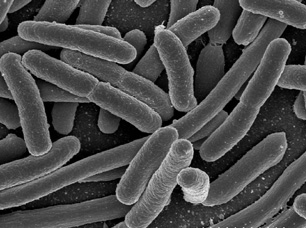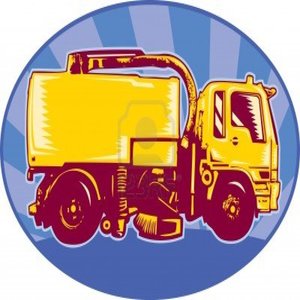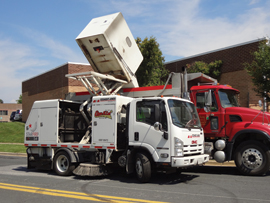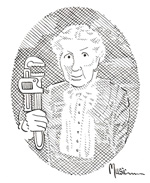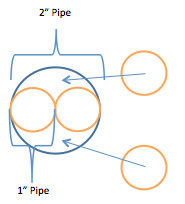Pure Water Occasional, October 2, 2017 |
In this early autumn Occasional you'll hear about Tippecanoe darters, water filtering worms, carbon nanotubes, the Guajataca Dam, the world's largest water treatment plant, and the world's most popular bacterium. Find out how fires and leaves pollute water and how street sweepers keep it clean. Learn how many 1" pipes will fit into a 2" pipe, what kinds of plastic are in reverse osmosis tanks, how cities manage to lose very large amounts of water, and which side of the tracks has better water. And, as always, there is much, much more.
|
World's Largest Water Treatment Plant
by Peter Chawaga
|
Well before Hurricane Harvey brought torrential winds and stormwater into Houston, the city had a reputation for ambitious construction and sprawling development.
In a project that demonstrates this city’s spirit, Houston will soon be home to the world’s largest water purification facility, which broke ground earlier this month.
“The Northeast Water Purification Plant Expansion is currently the largest water treatment project on the planet — not just in the State of Texas, not just in the United States, but on the planet,” said Houston Mayor Sylvester Turner, according to the Houston Chronicle. “Can you imagine this plant just a couple of weeks ago was submerged under water, yet we are still here today?”
The city invested nearly $1.5 billion in the project, which includes the building of a high service pump station, ground storage tanks, and treatment facilities. It is expected to increase treated water capacity in the area to 320 million gallons per day (MGD).
“The project includes the design and construction of a new raw water facility, which includes an advanced three-level intake, pumping, and conveyance to withdraw water from Lake Houston and deliver it through two new 108 inch pipelines to the treatment facilities located about 1.5 miles from Lake Houston,” per Construction Equipment. “The undertaking involves moving water three miles over a ridge and into a 23-mile canal that will feed Lake Houston, then pumped through 17 miles of pipe large enough to drive a car through.”
The ambitious project is expected to meet a growing need for clean drinking water in the area.
“The Greater Houston Water Department says that by 2025, surface water — rather than groundwater — must supply at least 60 percent of the water used by the area,” Construction Equipment reported. “That percentage will rise to 80 percent by 2035. The reason is that with the rapid expansion of the Houston area, groundwater being pumped in Harris, Galveston, and Fort Bend counties has reached a point where the ground has sunk several feet, causing flooding. Some wells in the area have hit salty water and other have hit water that smells like sulfur.”
The project is expected to be complete by 2024.
|
E. Coli, the most popular bacterium
|
Rod-shaped E. coli are often about 2 microns long and half a micron across. This makes them big enought to be caught by a tight water filter. |
Escherichia coli, usually known simply as E. coli, was named after its discoverer Theodor Escherich, a German doctor in the 19th century. It is part of a family of fecal bacteria called coliform. It is found in the intestines of animals and humans and will grow in a wide range of intestinal environments. A typical E. coli measures about 2 microns by 0.5 microns and is rod shaped.
When water tests are done, a test is usually first performed for coliform, and if coliform is detected, E. coli, specifically, is looked for. Water can test positive for coliform bacteria without E. coli being present. Although finding E. coli is an immediate cause for concern, most strains of E. coli are harmless. A few strains, like O157:H7, O121 and O104:H21, cause serious disease.
E. coli can infect humans not only through contaminated water but also through foods like insufficiently cooked beef, contaminated and unwashed fresh vegetables, as well as milk or juice.
Presence of E. coli in water is a strong indication that water is contaminated by human or animal feces.
Health effects of E. coli range from no symptoms to death, although in most cases infected individuals recover without medical treatment. Serious outbreaks, though not frequent in this country, are impressive. In 1999 at a county fair in New York, a well at the fair used for drinking and food preparation was contaminated by manure from a nearby animal barn. The result was two deaths, 65 people hospitalized and more than 1,000 sickened.
The EPA considers detection of E. coli a “direct health risk,” and has set a maximum contaminant level (MCL) of zero for total coliforms.
Treatment of E. coli is varied. It includes ultrafiltration, nanofiltration, reverse osmosis, distillation, ultraviolet, chlorination, ozone, and boiling.
Reference: Water Technology.
|
Leaves and Water
by Gene Franks
|
October’s leaves were dancing ’round
like angels dressed in robes of Red and Gold
but November’s come and gone now
and they’re lying in the gutter out along the road
They’re gonna make their way out to the ditch or someday to the sea,
they’ll get to where they’re going without the help of you or me
and if each life is just a grain of sand
I’m telling you man, this grain of sand is mine.
|
Serious water issues from cyanobacterial blooms to dead spots in the ocean are regularly blamed on excessive nutrients, specifically nitrogen and phosphorous, that humans put into the water. These result mainly from fertilizers, animal manure (both from feedlots and companion animals), and overflows from sewage treatment plants.
But now comes a report by the U.S. Geological Survey telling us that failure to remove leaves from areas where they can be swept into stormwater collection systems can spike stormwater with phosphorus and nitrogen and greatly compromise water quality. In fact, leaf removal studies performed in Madison, WI, seemed to show that, at least during the time of year when leaves are most abundant, “. . .timely leaf removal reduced total phosphorous loads by 84 percent and nitrogen loads by 74 percent.” The conclusion was that phosphorous in wastewater could be greatly reduced if the city would collect leaves and clean streets weekly and before “rain events” between early September and mid-November.
Clearly, the Madison experiment is about big-time leaf harvesting by city crews, not about requiring individual tree owners to clean up after their trees the way that pet owners are now supposed to pick up after their dogs. At least, as a confirmed non-raker, that’s what I hope it means.
The issue seems to be that, as one writer puts it, “. . .when water managers have run out of other levers to pull, [leaf removal] is an effort that should be prioritized.” I would put it more bluntly: Since we can’t get profit-driven corporate farmers to adopt saner and more earth-friendly growing methods, and we can’t expect people to cut back on the meat and dairy diet that is burying us in animal feces, and we can’t ask people to give up their pets, and since we certainly can’t ask people to pay a bit more for water or to agree to increase their taxes so that our ancient sewage treatment plants can be upgraded, we should concentrate our efforts on picking up leaves.
While we have to applaud any effort to keep water clean, leaf management seems like a pretty tricky business. For example, if leaf collecting becomes a national nutrient reduction strategy, what are we going to do with all the leaves we collect? Landfills are already bulging. Are we going to inject them into deep wells, like fracking waste, or haul them to leaf disposal sites in the desert? Will we eventually try to genetically engineer leafless trees, or trees whose leaves are permanently attached?
Keeping the streets clean is an essential part of wastewater management. It is certainly better to sweep up contaminants before they get into the water than to remove them from the water later. But on the broader leaf issue, I’m still a non-raker. As Iris DeMent says in her great anthem to personal freedom, leaves should be left to “get to where they’re going without the help of you and me.”
So there!
|
Street Sweepers Clean More Than the Streets |
|
We usually think of street sweepers as big noisy machines that stir up dust and pick up some dirt, leaving the street looking a little nicer. What we don’t consider is that street sweepers are an essential part of water treatment.
What we call ‘street dirt’ is composed of heavy metals and other pollutants—items that may be killing fish when they get into waterways via stormwater runoff. Cities use media filters to clean stormwater, but it is estimated that effective street cleaning can greatly lessen the cost of filtering. Cleaning the street as compared with filtering costs about one-forth as much, in fact.
Heavy metals like cadmium, copper, lead, zinc are specific pollutants that are found in abundance in “street dirt.” In 1972, in the first USEPA publication ever on stormwater, street dirt was named as “the primary source of contamination, in terms of mass.”
Much of the toxic debris that washes to storm drains from the street is from automobiles. Brake pads, for example, especially cheap brake pads, deposit large amounts of copper into the streets. This copper ends up in the water supply unless it is caught in a filter or, more economically, swept up by a street cleaning machine.
Street sweeping machines vary in sophistication. Early models, which go back centuries, were used for picking up horse manure before the advent of the automobile. In the early 20th century, many US cities used them, but they were of limited effectiveness.
Mechanical machines, which use a main broom and conveyor belt to pick up material, have been around at least 100 years. Their basic design hasn’t changed that much, although impressive improvements have been made, such as the broom design and speed, and the conveyor belt speed and alignment. The mechanical machines are still the most popular, and perhaps 90% of the sweeping machines in operation are of the mechanical broom design.
Newer designs include “regenerative air” units which in one motion blow air down on the pavement to dislodge debris then immediately vacuum the dirt into a hopper. These are sometimes unpopular because unless they include air filters they stir up lots of dust. Vacuum machines can be very effective.
Even more advanced designs use water. One machine features “rotary arms with nozzles on the end that blow water down on the pavement; the back end of the machine features a powerful vacuum and a squeegee that sucks up the water and the debris it contains.”
The “state of the art” machine called the Schwarze A7000 costs in the neighborhood of $170,000.
The effectiveness of the machine, of course, is determined by how much dirt the machine actually picks up. Ineffective machines simply move some of the dirt to a different location. The worst street cleaner of all time, of course, as well as probably the stupidest machine ever devised, is the common leaf blower, which does not remove dirt but simply moves it to a less visible spot.
|
Most street sweepers are still of the mechanical broom design.
|
BPA in Reverse Osmosis Storage Tanks
|
Because of the widely publicized presence of BPA in some plastic products, the public has developed a general suspicion of all plastics as a source of BPA. Actually, the plastic products that contain BPA are mainly the hard, shatter-resistant, usually clear water bottles as well as baby bottles and a few other plastic containers. You normally will not find BPA in plastics like polypropylene and polyethylene. BPA is not one of the materials used in preparing these plastics.
If a product is NSF certified (certified to ANSI/NSF standard 58), the certifying agency has scanned the product for BPA. If the product contains BPA, it will fail the extraction test and will not be certified.
The materials in high quality RO tanks that touch the water are stainless steel (the spout only), polypropylene (the liner in the chamber that holds the water), and butyl (the bladder that holds air and pushes the water out of the tank). The butyl (aka chlorobutyl) bladder material in high quality tanks is specially cured so that it will not put out bad tastes or contaminants.
There are lots of things that contaminate food and water that we should worry about but reverse osmosis tanks aren’t one of them.
|
Ryan's Pipe Sizing Rules
by Pure Water Annie |
In this article Gazette technical wizard Pure Water Annie channels another technical writer, Ryan Lessing, of Watts Water Quality.
|
In a recent Watts email newsletter, the Water Pro Insider, Watts enginerring department technician Ryan Lessing's technical tips column focuses on a frequent misconception about pipe sizes and flow rates. This is good information to know even if you aren't a plumber. If you are a plumber, you'd better know it, but if you're just building a fish pond or running a water pipe to your barn or adding a sprinkler to water your blackberry vines, you can get into a lot of trouble if you don't take pipe sizes into account. Here's what Ryan has to say:
|
"From time to time I hear people say, 'I have a 2 inch pipe so I am going to install two 1 inch filters in parallel.'
Or they state something like, 'I needed the flow rate of a 3 inch pipe so I ran two 1½ inch pipes in parallel.'
Flow rate and pipe size correlation is not as simple as adding pipe diameters together, such as 1 inch pipe + 1 inch pipe = 2 inch pipe.
The rule of thumb is twice the diameter equals four times the flow.
You can see in the figure below that four 1 inch pipes can fit inside a 2 inch pipe."
|
"To estimate the pipe size required for a certain flow rate, the following formula can be used.
gallons per minute (GPM) = diameter * diameter * 2.448 * velocity (in feet per second)
Use a maximum flow velocity of 8.2 feet per second.
The formula works for estimating pipe size requirements for short runs, such as 20 linear feet, in the installation plumbing only. It is not intended for longer plumbing runs, where more details need to be taken into account.
So for 2 inch pipe, the formula would call for 80 GPM peak flow rate:
2 inch * 2 inch * 2.448 * 8.2 feet per second = 80 GPM
Or for 1 inch pipe, the formula would call for 20 GPM peak flow rate:
1 inch * 1 inch * 2.448 * 8.2 feet per second = 20 GPM
Notice how 80 GPM for 2 inch pipe is 4 times as much as the 20 GPM for 1 inch pipe."
As a final note, I’m sure you noticed how much Ryan’s logo is like mine. Except to point out that my logo was made before color pictures were invented, I’ll leave it to you to figure out who has borrowed from whom.
|
Ryan Lessing formerly worked for Alamo Water in San Antonio and has been with Watts in San Antonio for several years. He is an active supporter of the Texas Water Quality Association chapter and is a past-president of the organization. He is also a bluegrass musician and a very nice person.
|
Every municipal water system leaks. Billions of gallons of water are lost every day from U.S. drinking water systems.
The city of Joliet, Illinois recently raised its water rates but was also forced to enter into a serious discussion about where 1/3 of its water goes. A full 33 percent of the water produced by the city for sale is not being sold and for the most part is unaccounted for.
What’s worse, the amount or “lost” water is increasing every year. “Acceptable” water loss for cities is around 8%. Leaks account for most of this. A certain amount of leakage is inevitable, and it’s hard to find leaks in pipes that are 10 feet underground. Big leaks, like main breaks, can be estimated and thus “accounted for.” Also, the city can keep estimated records on water used for firefighting and street cleaning.
Inaccurate meters also account for a lot of the lost water. Meters, especially old ones, sometimes underestimate usage and the water that doesn’t get billed makes up part of the city’s lost water total. It isn’t unusual for some customers to get free water simply because of glitches in the billing system. What they get is, to the city, “lost” water.
Finding lost water is much harder than one might think. The city of Joliet hired a consulting firm that took a hard look and concluded that it did not know where the unbilled water was going. What they did conclude, however, was that the city was spending way too little to maintain it’s water lines.
The city of Joliet is not an extreme case. It is not uncommon to hear of water utilities that only bill for 50% or less of the water that they treat and pump to distribution. Studies have estimated that as much as 5.9 billion gallons per day of water is lost to leakage, poor accounting and other unbilled consumption in the United States. This is more than enough water to supply the ten largest cities of the United States.
|
Manual Filter Controls: Sometimes Simple is Better
by Gene Franks
|
Backwashing water filters used for removal of sediment, chlorine, chemicals, iron, hydrogen sulfide odor, and many other water contaminants are regulated by control devices that range from simple to very complex. The main function of the valve is to control the time and duration of backwash (where water is reversed in the filter tank to clean and resettle the media bed) and rinse (where water is pushed downward through the media at a fast rate to rinse and settle it after the backwash).
These functions can be controlled by fully electronic or electrically driven mechanical timing devices that regenerate the filter at preset times and for preset durations. The electronic versions are more versatile than the mechanical and offer many more options. For example, an electronic controller can be set up to regenerate the filter every other Sunday at 3:51 AM, backwashing for 6 minutes then rinsing for one minute. Depending on the product, mechanical timers offer fewer options. With the most popular mechanical control (the Fleck 5600), for example, you could choose to regenerate every day, every other day, every third day, fourth day, every sixth day, or every 12th day, but you could not choose to regenerate every Sunday or every eighth day. With the standard 5600 you also have no control over duration of the functions: it’s a 15 minute backwash and a 10 minute rinse whether your filter needs this much time or not. (Unless you’re running an iron filter or have very sandy well water, you probably don’t need this much time, but the filter is preset to accommodate the “worst case” user so even clean city water gets a 15-minute backwash.)
Totally Manual Control
A less frequently used control valve is the totally manual (non-electric) Fleck 2510 control pictured below.
This control valve requires no electricity and no programming. It has a three-choice selection lever that send water to the home (Service position), backwashes the filter, or rinses the filter.
This very simple valve not only costs less, but it works better in some situations than more expensive controllers. Here are some examples:
- Remote areas where there is no electricity.
- If you have electricity, but it isn’t dependable. It’s easier to manually regenerate a filter than to repeatedly reset an electric control system.
- Seasonal homes or homes where the inhabitants travel frequently. It’s easier to backwash your filter manually than to constantly reset an automatic system to fit your schedule.
- When backwash duration requirement might change. Some wells take on large amounts of sediment after a rain, or a city water filter might pick up a large amount of dirt when there is city water line maintenance. At such times, it’s easier to simply give the filter its needed backwash manually than to reprogram your electronic controller.
- If price is important. Substituting a manual backwash control can cut several dollars off the purchase price of a standard backwashing filter.
- If saving water is important. If you want to backwash your clean city water carbon backwashing filter once a month for five minutes only (not an unreasonable schedule). you can save almost 300 gallons per month, as compared with a standard electro-mechanical control valve!
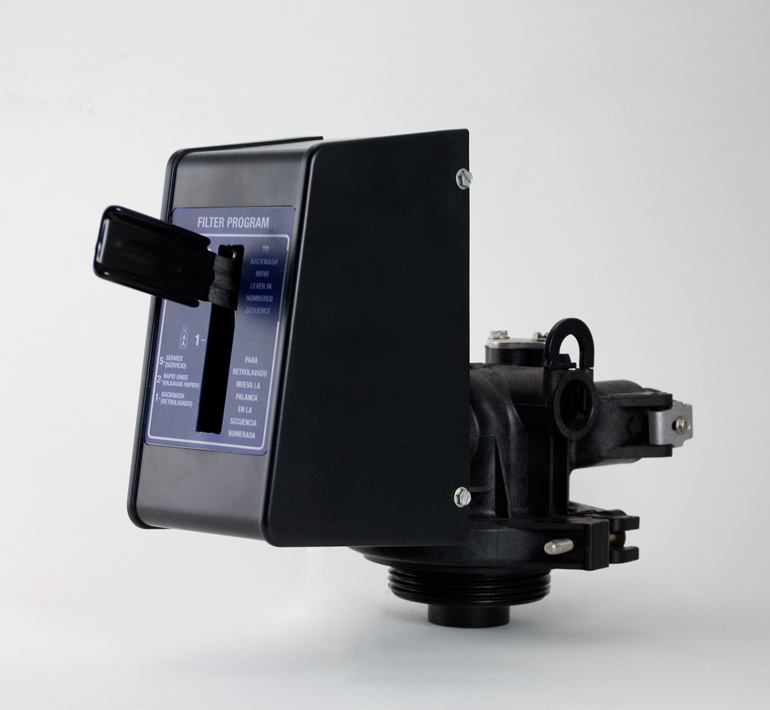
You can find a manual controller as well as a variety of automatic controllers here.
|
Here are just a few of the many articles about water issues that are available every day from the Pure Water Gazette website. Visit the site regularly to keep up with the latest happenings in the fascinating world of water. |
Lead removal in schools
Water filters to remove lead will be installed in all New Orleans schools this fall.
Tippecanoe darters indicate improved water quality
An Ohio Dominican University icthyology class found rare small perch called Tippecanoe darters in a waterway that flows through campus. The fish has not been seen in many years, and its presence is seen as a sign that local efforts to improve water quality are working.
Alternative treatment to wastewater generated by cows
A dairy farm in Washington is trying a unique process to treat the wastewater generated by its 7,000 cows. The effluent is sprayed into giant boxes filled with earthworms. Then, the worms, together with a casserold of microbes, consume the contaminants in the wastewater, leaving behind water clean enough to irrigate crops.
New technology to remove salt from seawater
Scientists at Lawrence Liversmore Lab, in collaboration with Northeastern University reserachers, have developed carbon nanotube pores that can exclude salt from seawater. The nanotubes, hollows structures made of carbon atoms in a unique arrangement, are more than 50,000 times thinner than a human hair. The super smooth inner surface of the nanotube is responsible for their remarkably high water permeability, while the tiny pore size blocks larger salt ions. The team also found that water permeability in carbon nanotubes (CNTs) with diameters smaller than a nanometer (0.8 nm) exceeds that of wider carbon nanotubes by an order of magnitude.
Does water consumption prevent sunburns?
Quarterback, Tom Brady, asserted that drinking lots of water can prevent sunburn.
Wildfires contribute to increased sedimentation in watersheds
New research predicts that an increase in the frequency and magnitude of wildfires will double the rates of sedimentation in one-third of the West's large watersheds, reducing reservoir storage and affecting water supplies. According to a new study from the U.S. Geological Survey, in many regions erosion rates are accelerating because of wildfires and climate change. In almost 9 out of 10 of the watersheds assessed, sedimentation could increase by at least 10 percent. In some watersheds, the increase could be by 1,000 percent.
Game encourages people to avoid drinking water
Gatorade was fined $300,000 by California for false advertising because of its free mobile game, "Bolt!," in which players are encouraged to "keep your performance high and avoid water."
Dam in Puerto Rico in danger of failing
Puerto Rico's Guajataca dam, which was built in 1929, used for public water and irrigation water supply, is in danger of breaking. Its demise could endanger as many as 70,000 people who live downstream. The reservoir has a water storage capacity of 11 billion gallons.
EPA response to hurricanes
The U.S. Environmental Protection Agency (EPA) has approximately 80 personnel currently involved in hurricane efforts.
Follow daily water headlines and links to full articles from Environment Health News at the Pure Water Gazette.
|
New on the Pure Water Gazette website:
Tap Water Problems Found to be More Prevalent in Poor, Minority Communities
by Sara Jerome
|
Places to visit on our websites |
Thanks for reading and be sure to check out the next Occasional!
|
|
|
|  | |



